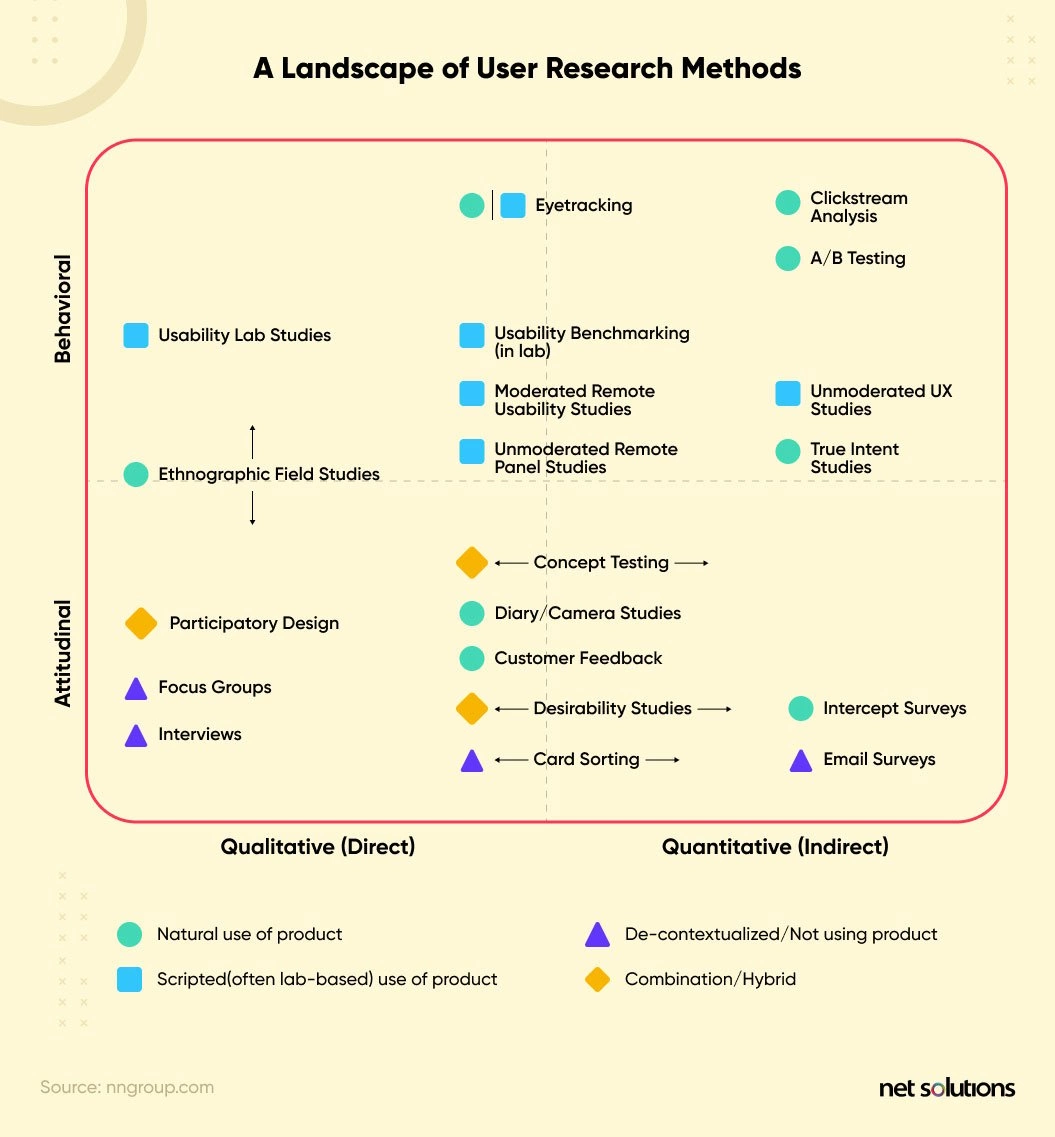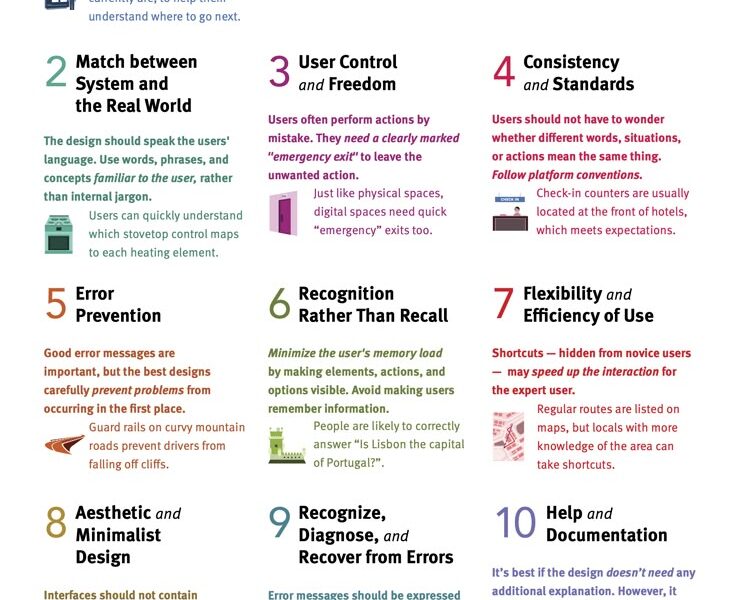Research Methods: The Master Strategist’s Guide to Unlocking User Truths
As a UX veteran, I’ve learned this brutal truth: Choosing the wrong research methods costs companies $2.4M per project (IBM Research).
That landscape graphic you’re seeing? It’s not just a pretty chart—it’s your battle map for navigating the minefield of user insights. Let’s decode it together.
The Research Methods Matrix: Your Navigation Compass
Based on NN/g’s legendary framework from your image, research methods live in four strategic quadrants:
The Axes That Define Everything
Qualitative (Direct) ↔ Quantitative (Indirect)
Behavioral (Observed Actions) ↔ Attitudinal (Stated Beliefs)
“Behavioral data tells you what they do, attitudinal reveals why they think they do it.” – Don Norman, Author of The Design of Everyday Things
The 5 Dimensions of Research Strategy
Let’s dissect each dimension with surgical precision—including when to deploy them and catastrophic mistakes to avoid.
1. Quantitative vs. Qualitative: The “What” vs. “Why” War
Quantitative (The Magnifying Glass)
Tools: Google Analytics (behavioral flows), SurveyMonkey (statistical significance)
Case Study: Amazon increased conversions 35% by tracking clickstream patterns (Source)
Landscape Methods: A/B Testing, Clickstream Analysis, Email Surveys
Qualitative (The Microscope)
Tools: Dovetail (thematic analysis), Lookback (live observation)
Pro Tip: Record micro-expressions with OBS Studio during interviews
Landscape Methods: Ethnographic Studies, Diary Studies, Contextual Inquiry
Critical Insight: Blend them. Spotify combines playlist analytics (quant) with emotion-tracking diaries (qual) to predict hits.
2. Attitudinal vs. Behavioral: The Say-Do Chasm
Attitudinal (The Stated Truth)
When to Use: Testing brand perception pre-launch
Danger Zone: 72% of users lie in self-reports (Harvard Business Review)
Landscape Methods: Focus Groups, Desirability Studies
Behavioral (The Unfiltered Truth)
When to Use: Optimizing checkout flows
Golden Tool: Hotjar Session Recordings (watch cursor hesitation)
Landscape Methods: Eye Tracking, True Intent Studies, Usability Benchmarking
Case Study: When PayPal discovered users said they wanted “security” but behaved by abandoning password resets, they simplified recovery flows—reducing drop-offs by 22% (PayPal UX Lab).
3. Moderated vs. Unmoderated: The Control Spectrum
| Factor | Moderated | Unmoderated |
|---|---|---|
| Depth | Probe “Why did you hesitate?” | Scalable but shallow |
| Tools | Zoom + Calendly scheduling | UserTesting.com platforms |
| Cost | $150+/session | $40/session |
| Best For | Complex medical interfaces | E-commerce button testing |
Landscape Crossover: Moderated Remote Usability (hybrid approach) saves 60% time vs. lab studies (NN/g).
4. Remote vs. In-Person: The Context Tradeoff
Remote (The Global Reach)
Killer App: Maze for prototype testing across 12 time zones
Context Loss: Misses kitchen sticky-note systems in healthcare studies
In-Person (The Context King)
When Essential: Observing factory floor tablet use
Toolkit: GoPro for hands-free ethnographic recording
ROI Boost: In-person banking app tests revealed 43% more pain points than remote (Citi UX Report)
5. Generative vs. Evaluative: The Innovation Engine
Generative (The Discovery Phase)
Methods: Participatory Design, Concept Testing
Framework: Design Sprints (GV)
Output: Airbnb’s “Experiences” feature born from traveler diaries
Evaluative (The Validation Phase)
Methods: Usability Benchmarking, A/B Tests
Framework: RITE (Rapid Iterative Testing)
Impact: Slack’s threaded conversations improved task completion by 31% post-testing (Slack Engineering)
The Method Matchmaker: Choosing Your Arsenal
Adapted from NN/g’s landscape with battle-tested recommendations
| Goal | Top 3 Methods | Tools |
|---|---|---|
| Discover Unmet Needs | 1. Ethnographic Studies 2. Diary/Camera Studies 3. Contextual Inquiry | Dscout, Notion |
| Test Usability | 1. Moderated Lab Studies 2. Unmoderated Remote Tests 3. Eye Tracking | UserTesting, Tobii Pro |
| Validate Concepts | 1. Desirability Studies 2. Concept Testing 3. Focus Groups | Figma, UsabilityHub |
| Optimize Flows | 1. A/B Testing 2. True Intent Studies 3. Clickstream Analysis | Optimizely, Hotjar |
Researcher vs. Designer: Skills for Each Method
(Data synthesized from 2024 UXPA salary reports)
| Method | Researcher Superpower | Designer Must-Have |
|---|---|---|
| Ethnographic Studies | Cultural sensitivity | Journey mapping skills |
| A/B Testing | Statistical significance mastery | UI variant creation speed |
| Card Sorting | Taxonomy design | Information architecture sense |
| Diary Studies | Longitudinal analysis | Empathy for pain point synthesis |
Career Hack: Designers—master moderated testing. Researchers—learn quantitative tools like SQL. Hybrids earn 32% more (ADP List data).
Frameworks That Prevent Research Waste
The Research Canvas
Purpose: Align stakeholders on goals/methods
Template: UXPressia’s Free Download
Continuous Research Loop
Discover → Prototype → Validate → Implement → Measure
Used by: Spotify tests 200+ features weekly
Triangulation Framework
Combine 3 methods (e.g., Survey + Analytics + Interview) to kill biasCase: Dropbox reduced false insights by 70% (Dropbox Design)
The Tool Stack of Research Titans
Generative Research: Miro for virtual workshops, Sprintbase for remote design sprints
Behavioral Tracking: FullStory for frustration signals, Mouseflow for heatmaps
Synthesis: Dovetail (AI-powered tagging), Airtable for repositories
Pro Tip: Build a research repository. Atlassian cut onboarding time 40% using Confluence templates.
Catastrophic Mistakes & How to Avoid Them
The N=5 Trap
Fact: 5 users find 85% of usability issues but 0% of market needs
Fix: Pair usability tests with 500+ respondent surveys
Lab Bias
Danger: Users behave differently in sterile labs
Solution: Run contextual inquiries in real environments
Zombie Research
Data: Insights decay after 6 months (MIT Sloan Study)
Antidote: Quarterly research “health checks”
The Future: AI’s Research Revolution
Synthetic Users: Test concepts in minutes with UserTesting AI
Predictive Analytics: Heatmap.com forecasts usability issues pre-launch
Neuro UX: Pupil Labs eye tracking + EEG for emotional response mapping
Your Research Strategy Blueprint
Map Your Goal to NN/g’s landscape quadrants
Mix Methods like a bartender (e.g., qual + quant)
Tool Stack based on budget (start with Hotjar/Maze)
Skill Bridge—designers learn interviewing; researchers study stats
“Research without strategy is noise. Strategy without research is arrogance.”
Free Resource Bundle:
Further Reading:
Just Enough Research by Erika Hall
Image belongs to NetSolutions.


